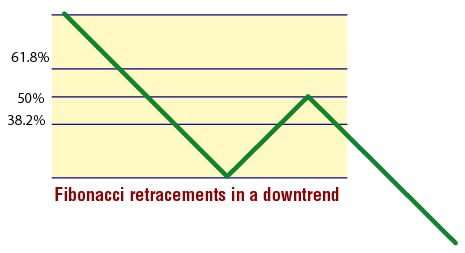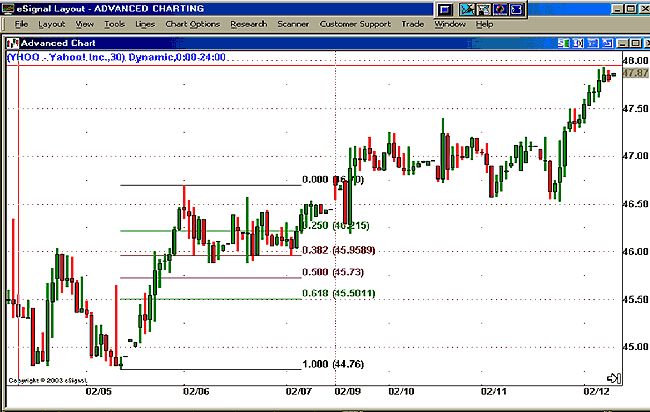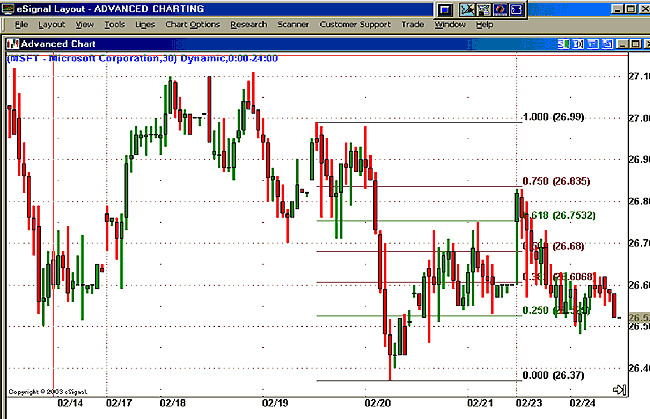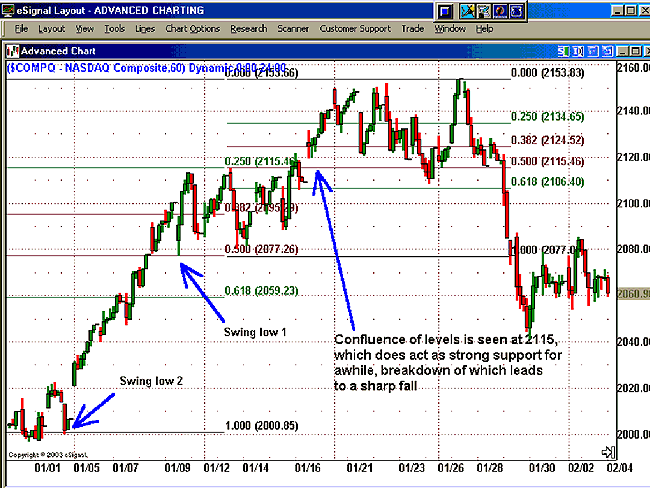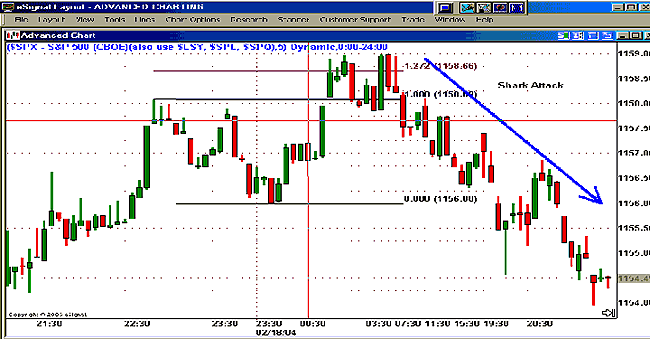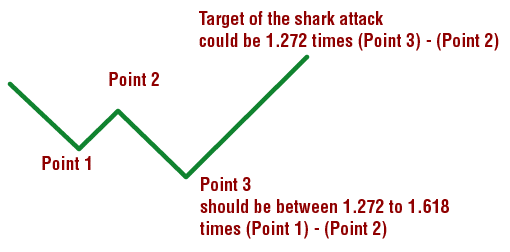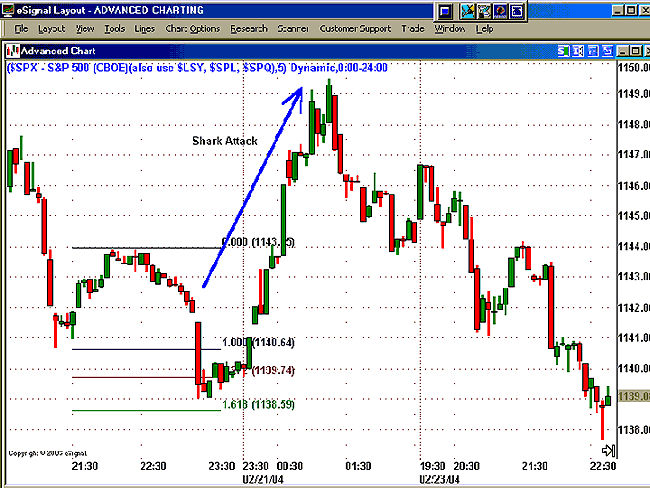
HOT TOPICS LIST
- Strategies
- Stocks
- Buy
- Investing
- Brokers
- Psychology
- Interviews
- Accumulate
- Sell
- Hold
- Spotlight
- Websites
- Candlestick Corner
- Gold & Metals
- Options Trading
LIST OF TOPICS
THE CHARTIST
The Shark Attack Strategy And Fibonacci Levels
03/17/04 03:59:37 PM PSTby Ashwani Gujral
Discovered long before there were stock markets, the Fibonacci method has proved to be useful for traders.
| One of the key goals of stock market traders is to find a way out of the maze of the stock market. Toward this goal, traders have resorted to using astrology, rocket science, fundamental analysis, technical analysis, and more to achieve this goal. The Fibonacci method is one such attempt to unravel the mysteries of the stock market, in this case by relating the market's movements to the Fibonacci series. Fibonacci series were discovered long before there were stock markets, but they relate amazingly well to the stock markets and other natural phenomena. Leonardo of Pisa, a 13th-century Italian mathematician better known by his nickname, Fibonacci, is credited with the creation of the Fibonacci series. The series has its first two numbers as zero and 1. You arrive at the remaining numbers by adding the previous two numbers. For example, Thus, we arrive at a series of numbers: zero,1,1,2,3,5,8,13,21, 34, 55, 89. These numbers are related to each other by a ratio. Many phenomena in nature, science, and astrology can be explained by using this property of the Fibonacci numbers. Fibonacci numbers also have an interesting relationship with each other. Using the sums from the examples above, we get 21/34 = 0.618; 34/55 = 0.618; 55/89 = 0.618. Similarly, 34/21 = 1.618; 55/34 = 1.618, 89/55 = 1.618. This ratio is known as the golden ratio and forms the basis of the Fibonacci methods in technical analysis. The other two fractions, 0.382 and 0.5, most commonly used in technical analysis are calculated as follows:
(1 - 0.618) = 0.382 and 0.5 is the mean of 0.382 and 0.618.
FIBONACCI RETRACEMENTSFibonacci retracement tools are conveniently available in most software packages. To use it, we must:
Figure 1: Fibonacci retracements in an uptrend
Figure 2: Fibonacci retracements in a downtrend
Figures 3 and 4 display examples of Fibonacci retracement levels in upswings and downswings.
Figure 3: Fibonacci retracement levels in an upswing
Figure 4: Fibonacci retracement levels in a downswing
CONFLUENCE OF FIBONACCI LEVELSWith almost five Fibonacci levels to contend with, traders can often be confused. They are often left wondering which of the levels might most likely hold. In such cases,
The 60-minute chart of the Nasdaq composite in Figure 5 shows the confluence of levels at 2115, which acts as a strong support.
Figure 5: Nasdaq composite 60-minute chart
SHARK ATTACKNow, here's a strategy using the Fibonacci levels. This strategy, developed by Derrik S. Hobbs, is available in his book Fibonacci For The Active Trader. The shark attack strategy details how retail traders are learning conventional, predictable theories in technical analysis and are not doing themselves any good. Haven't you seen it happen? Think of it. Whenever you position yourself for what you believe is a sure traditional setup, smart traders and institutions come in and move the market sharply in the opposite direction, coming in for the kill, much the way sharks do instinctively. In this, the shark attack is similar to the turtle soup strategy made popular by Larry Connors and Linda Bradford Raschke in their book, Street Smarts. That strategy is another example of how smart traders and institutions take advantage of retail traders using traditional setups who become trapped on the other side of the trade. If you become aware of how the shark attack strategy works, you can avoid the consequences. Here's how the shark attack strategy can be used with Fibonacci levels for both short trades and long trades:
Conditions for the short trade (Figures 6 and 7) Assume the market is in an upswing and forms a swing high point 1, retracing normally to point 2. I wait for the market to test the previous top. Two possibilities arise: 1 The market forms a double top and comes down sharply. 2 The market breaks the previous top and continues to rally to point 3.
Figure 6: Short trade shark attack
Figure 7: Short trade shark attack
The third possibility is the shark attack that is, the market breaks its previous top and rallies between 1.272 and 1.618 of the previous correction, which is point 3, and retail traders go long with it. After this, a sharp decline takes place, taking the market down to at least 1.272 of the last rally. At that point, pressured retail traders scamper away, and should prepare for shark attacks whenever traders act in a bullish or bearish consensus, expecting a breakdown or breakout. The short trade can be taken when the low of the previous bar is broken and the second higher high can be used as the stop-loss. The profits on the short side can be 1.272 times the difference of point 3 and point 2.
Conditions for the long trade (Figures 8 and 9) The converse is true for the long trade. Assume the market is in a downswing and makes a swing low at point 1, and retraces upward to point 2. You should wait for the market to test the previous bottom. The market could either form a double bottom and rally sharply or break the previous bottom and continue to decline to point 3.
Figure 8: Long trade shark attack
Figure 9: Long trade shark attack
Once again, another possibility is the shark attack, which occurs when the market breaks its previous bottom and declines to about 1.272 and 1.618 of the previous correction (point 3), making retail traders go short with it. After this a sharp rally takes place, taking the market up to at least 1.272 of the last correction, as once again, pressured retail traders scamper away and cover their short positions. The long trade can be taken when the high of the previous bar is broken and the second lower low can be used as the stop-loss. In both the long and short trades, traders must tread with caution on the simple breakout/breakdown trades and should be ready for shark attacks whenever retail traders act in a bullish or bearish consensus expecting a breakdown or breakout. These trading strategies have some differences from the strategy that Derrik Hobbs uses, but the principles are the same.
Ashwani Gujral is an India-based technical analyst, commentator, author, and trainer. He follows both Indian and US markets. He is an active short-term trader and money manager.
SUGGESTED READINGConnors, Laurence A., and Linda Bradford Raschke [1995]. Street Smarts: High Probability Trading Strategies for the Futures and Equities Markets, M. Gordon Publishing Group, www.mgordonpub.com.Hobbs, Derrik S. [2003]. Fibonacci For The Active Trader, TradingMarkets Publishing Group Charts courtesy of eSignal
Current and past articles from Working Money, The Investors' Magazine, can be found at Working-Money.com. |
PRINT THIS ARTICLE

|

Request Information From Our Sponsors
- VectorVest, Inc.
- Executive Premier Workshop
- One-Day Options Course
- OptionsPro
- Retirement Income Workshop
- Sure-Fire Trading Systems (VectorVest, Inc.)
- Trading as a Business Workshop
- VectorVest 7 EOD
- VectorVest 7 RealTime/IntraDay
- VectorVest AutoTester
- VectorVest Educational Services
- VectorVest OnLine
- VectorVest Options Analyzer
- VectorVest ProGraphics v6.0
- VectorVest ProTrader 7
- VectorVest RealTime Derby Tool
- VectorVest Simulator
- VectorVest Variator
- VectorVest Watchdog
- StockCharts.com, Inc.
- Candle Patterns
- Candlestick Charting Explained
- Intermarket Technical Analysis
- John Murphy on Chart Analysis
- John Murphy's Chart Pattern Recognition
- John Murphy's Market Message
- MurphyExplainsMarketAnalysis-Intermarket Analysis
- MurphyExplainsMarketAnalysis-Visual Analysis
- StockCharts.com
- Technical Analysis of the Financial Markets
- The Visual Investor


